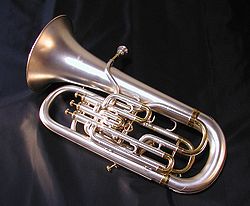Baritono
 |
|
| Classification | Aerophone |
|---|---|
| Hornbostel–Sachs classification | 423.232 (Valved aerophone sounded by lip movement) |
| Developed | 1840s from the ophicleide |
| Playing range | |
| This image represents the range for the instrument as it is commonly played. | |
| Related instruments | |
The euphonium is a large, conical-bore, baritone-voiced brass instrument that derives its name from the Ancient Greek word εὔφωνος euphōnos, meaning "well-sounding" or "sweet-voiced" (εὖ eu means "well" or "good" and φωνή phōnē means "sound", hence "of good sound"). The euphonium is a valved instrument; nearly all current models are piston valved, though rotary valved models do exist. The euphonium is a non-transposing instrument known for its distinctive tone color. A person who plays the euphonium is sometimes called a euphoniumist, euphophonist, or a euphonist, while British players often colloquially refer to themselves as euphists, or euphologists. Similarly, the instrument itself is often referred to as eupho or euph.
The euphonium is part of the family of brass instruments. It is sometimes confused with the baritone horn. The euphonium and the baritone differ in that the bore size of the baritone horn is typically smaller than that of the euphonium, and the baritone is primarily cylindrical bore, whereas the euphonium is predominantly conical bore. The two instruments are easily interchangeable to the player, with some modification of breath and embouchure, since the two have identical range and essentially identical fingering. The cylindrical baritone offers a brighter sound and the conical euphonium offers a mellower sound.
The so-called American baritone, featuring three valves on the front of the instrument and a curved, forward-pointing bell, was dominant in American school bands throughout most of the 20th century, its weight, shape, and configuration conforming to the needs of the marching band. While this instrument is in reality a conical-cylindrical bore hybrid, neither fully euphonium nor baritone, it was almost universally labeled a "baritone" by both band directors and composers, thus contributing to the confusion of terminology in the United States.
...
Wikipedia

